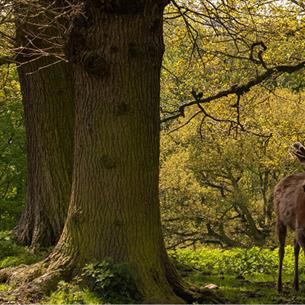Kynren – The Storied Lands

Things to Do in Durham
Planning Your Trip

Welcome to the Itinerary Planner. Use this tool to build your own journey or choose from an exciting range of specially selected tours.
To build your own Itinerary, click  to add an item to your Itinerary basket.
to add an item to your Itinerary basket.

You are here > Home > Things to Do > Castle Eden Dene - The Squirrel Walk
Tel: +44 0191 5860004
The Squirrel Walk - 1.8 miles (3km) between 1-2 hours. Follow the squirrel markers. Not suitable for pushchairs. Sturdy footwear recommended. Steep in places. Avoid visiting during high winds. Disabled access is very limited due to natural features. Please call in advance to discuss.
From the car park at the lodge, pass through the kissing gate and follow the broad path down the hill. Do not bear left but continue straight on, bearing slightly right and rising gently uphill. This is a good spot to see spectacular patches of giant horsetail, an incredible plant that’s changed little since prehistoric times.
As you follow the main path, look out for primrose, wild garlic and wood anemones in spring. In early summer you may see bluebells, while in late summer and autumn it’s time to admire the glowing red berries of wild arum or Lords and Ladies.
Sycamore and rhododendron, beautiful in the right place, are invaders here. They make it hard for native species to grow and Natural England are committed to removing them from areas where they are yet to take hold completely. At the fork in the path, keep left.
If you’re lucky you may see a sparrowhawk swooping through the trees hunting for prey, while woodcocks enjoy the protection of the undergrowth. During the winter, look out for great spotted woodpeckers, in the early spring, when the leaves are back on the trees, listen out for their drumming.
After three quarters of a mile (1km), turn sharp left and follow the path as it drops down to Gunner’s Pool Bridge.
Look out for the speckled wood butterfly along any of the path sides. The male has wings spotted with orange, the female with yellow, and both love feeding on brambles.
Cross the bridge which dates from late 19th Century and was erected by the Burdon family who used live in the castle and own the Dene.
From the bridge, look down into the dramatic gorge and Gunner’s Pool, where according to legend, the Devil promised he would follow a man called Gunner up the Dene, gathering stone to build Durham Cathedral as he went. Gunner was forbidden from looking back as he walked. However, when Gunner heard a sound as if the sea were about to crash over him, he turned round. The Devil was furious and hurled a rock at him, and he’s said to still lie beneath the great rock which stands by the pool today.
At the bottom of the Dene, where conditions are always damp and moist, mosses, liverworts and ferns thrive. Look out too for the smooth green fronds of Harts Tongue fern.
At the far side of the bridge, turn left, staying well clear of the cliff edge. Continue on this path and enjoy the view out across the tree tops of the Dene. In October and November, hundreds of thrushes including blackbirds and redwings feed on the berries here, many having undergone long sea crossings from northern Europe.
Eventually the path bends left and downhill, on the corner there is a metal kissing gate that leads to the Castle and its drive which would take you to the village of Castle Eden and St James’ Church. Don’t go through this gate but continue downhill, bearing left at a fork in the path down to Castle Bridge. Cross the bridge and walk uphill, bearing right at the T junction to head back to the car park.
Route supplied by Castle Eden Dene National Nature Reserve.
| Season (1 Jan 2025 - 31 Dec 2025) |
|---|
 Castle Eden Dene National Nature Reserve, PeterleeCastle Eden Dene is a Site of Special Scientific Interest and is home to an extraordinary variety of birds, more than 450 species of plants, and some of our favourite mammals, such as roe deer and fox.
Castle Eden Dene National Nature Reserve, PeterleeCastle Eden Dene is a Site of Special Scientific Interest and is home to an extraordinary variety of birds, more than 450 species of plants, and some of our favourite mammals, such as roe deer and fox.
Heritage Centre with themed rooms. Mining Museum going back 100 years with 350 archives,…
Wheatley Hill Heritage Centre is small building of architectural beauty situated in…
Discover the Magic at The Hole In Wand – Dalton Park!
Step into a world of wonder at…
Experience the colourful and dramatic landscape of Durham’s Heritage Coast with its…
The multi award-winning Seaham Marina is County Durham's one and only marina. The marina…
The East Durham Heritage and Lifeboat Centre displays the historic lifeboat The George…
St Edmund's Church is over 750 years old with a 30m high Norman Tower visible for miles,…
This VisitEngland accredited attraction is an 18th Century parkland featuring beautiful…
The Gardens at Wynyard Hall are fast becoming one of the North’s leading visitor…
Rainton Meadows was created by the restoration of the Rye Hill Opencast coal mine in 1996…
Old Durham Gardens can be found less than a mile east of Durham City Centre. The gardens…
St. Giles’ has been a place for people to meet and worship for over 900 years.…
St Oswald’s is an Anglican church in the centre of the beautiful university and cathedral…
Set in countryside and mature woodland. Plant collections from North America, Himalayas…
The Prince Bishop River Cruiser offers cruises with spectacular views of historic Durham…
© Copyright Visit County Durham. All Rights Reserved
Registered Office: Visit County Durham, East Wing, 1st Floor, Corten House, Aykley Heads, Durham, DH1 5TS

